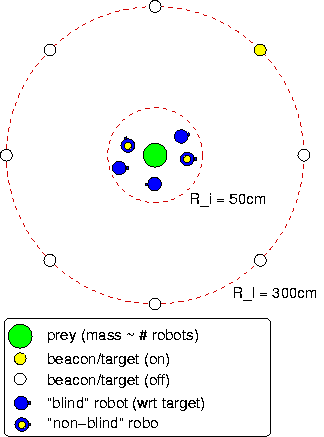|
Control >> Cooperative transport >> Blind and non-blind s-bots
Transport by swarms of blind and non-blind s-bots
In this study we focus on the situation in which some robots
of the
transport group are given the opportunity to localise the target,
while the others (called the blind ones) are not. We propose the use
of relatively simple robots capable of self-assembling into structures
which pull or push the prey. To enable a blind robot to contribute to
the group's performance, it can locally perceive traction forces, and
whether it is moving or not.
|
|
| A simulation lasts 35 simulated seconds. At any point
in time, there
is only one beacon (selected randomly) emitting light indicating the
target location. Initially, the prey is put in the centre, and N
s-bots are placed at random positions and with random orientations no
more than 50 cm from the prey. The s-bot controllers are supposed to
let the s-bots localise and approach the prey, self-assemble into
structures, each of them physically linked to the prey, and pull or
push the prey towards the light-emitting beacon. |

|
Experimental setup
We have decomposed the problem of control at the level of an s-bot into
sub problems:
- assembly,
- transport by non-blind s-bots,
- transport by blind s-bots.
The robot group is controlled in a distributed manner, using
this
modular control architecture. We investigated a collection of simple
hand-coded and artificially evolved control modules.
Results
We have considered groups of 2 to 16 s-bots. The mass of the
prey is
kept proportional to the group size. The performance measure we use
is the distance the prey gains wrt to the target location during the
entire simulation period (35 seconds).
Unless no robot was able to localise the target, having blind
robots
controlled by an evolved individual was superior in performance to the
alternative of removing them from the experiment. On the contrary, in
most of the trials, controlling the blind s-bots by the hand-coded
solutions was inferior in performance to the alternative of removing
them from the experiment. If no more than half of the robots were
blind, the contribution of the blind robots, if controlled by the best
evolved controller, was 40 to 60% of the contribution non-blind robots
would provide (in average) if put in the same situation.
For the best evolved solution the performance seems to scale
well with
group size, which should make it possible to transport heavier prey by
larger swarms of robots.
References
- Groß R. and Dorigo M. Group Transport of an
Object to a Target that Only Some Group Members May Sense, In Yao X., Burke
E., Lozano J. A., Smith J., Merelo-Guervós J. J ., Bullinaria
J. A., Rowe J., Tiňo P., Kabán A., and Schwefel H.-P.,
editors, Parallel Problem Solving from Nature - 8th International
Conference (PPSN VIII), volume
3242 of Lecture Notes in Computer Science, Springer
Verlag, Berlin, Germany (2004) 852-861
Control >> Cooperative transport >> Blind and non-blind s-bots
| 





